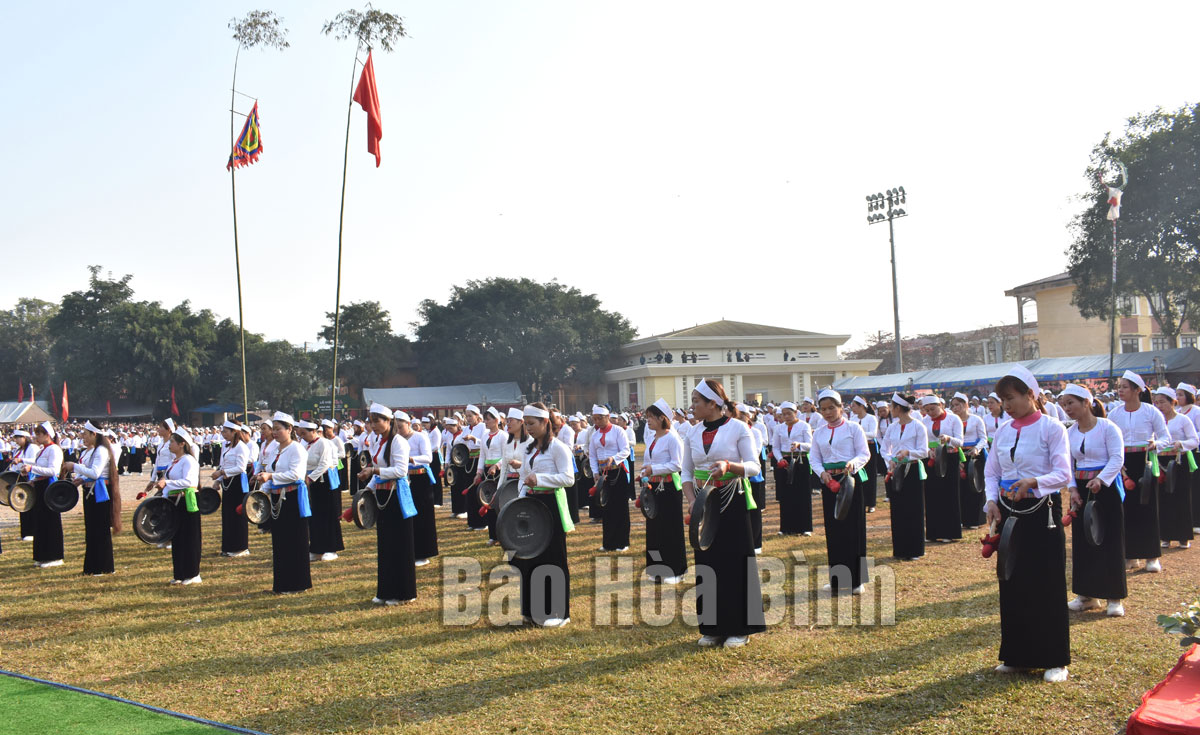
(HBO) - The Muong ethnic group in the northern province of Hoa Binh has over 40 major festivals yearly, and gongs are used in up to 90% of the festivals. For the Muong people in Hoa Binh, gongs are not only a kind of traditional musical instrument, but also a "sacred treasure", a spiritual story told by 12 national tones and an intangible cultural heritage with a strong vitality as they are preserved by the community.

500 Muong ethnic artisans and women perform
the gong in the Muong Ethnic Group Festival in 2023.
Muong Vang people in Lac Son district in particular and the Muong people in Hoa
Binh in general consider gongs as sacred objects, not merely musical
instruments. The sound of gongs is the soul of their culture, echoing the three
levels of the heavens, reaching the after-death world. The sound of gongs is
spiritually calling the Muong people’s ancestors. The Muong people have
absorbed that sound from the womb. When they die, the sound of gongs tells them
the way. Muong people believe that each gong has a spirit and a soul, so it is
a "sacred treasure" with profound spiritual values.
In the house of artisan Bui Ngoc Thuan, of Bung 1 hamlet, Thu Phong commune,
Cao Phong district, a set of Muong gongs is put in the most precious
place. Thuan usually uses his
gongs to teach the next generations. He said that everyone born as a Muong must know how to play Muong gongs.
At present, every commune in Cao Phong district has a Muong gong performance
team. The teams practice
traditional gongs so that they can perform at celebrations, traditional
festivals, and cultural exchanges. Old people teach young people, parents teach
their children, and senior teach beginners. In that way, the old generation
passes it on to the younger ones, and the gongs are kept in the
community.
Cao Phong district
boasts about 3,000 gongs. Hop Phong and Dung Phong are the two communes with
the largest number of gongs.
Meanwhile, Hoa Binh province still keeps more than 11,000 gongs, mostly in
the four districts of Lac Son, Tan Lac, Kim Boi, and Cao Phong, and Hoa Binh
city. To preserve a top typical cultural treasure of the Muong people in Hoa Binh,
the teaching of Muong gongs has been given much care. The province’s Department of Education and Training has actively cooperated
with the localities to have gongs lessons at schools.
The Women's Unions and Youth Unions at the grassroots level also hold classes
to teach Muong gongs. Every year, the province opens dozens of gong classes for
hamlets/communes musical groups.
Up to now, hundreds of clubs have been established across the province to
preserve and promote the values of Muong gongs. Muong gong performances have by now become an indispensable part of festivals
and celebrations in the province./.
With an increasingly vibrant and widespread emulation movement aimed at building cultured residential areas and cultured families, Yen Thuy District has been making steady progress toward improving both the material and spiritual well-being of its people, while fostering a civilized, prosperous, beautiful, and progressive community.
Once lacking recreational spaces and community facilities, Residential Group 2 in Quynh Lam Ward (Hoa Binh City) has recently received attention for the construction of a new, spacious, and fully equipped cultural house. The project followed the model of state support combined with public contributions in both labor and funding.
The "All people unite to build cultural life" movement, which has been effectively integrated with Kim Boi district’s socio-economic development goals, is fostering a lively spirit of emulation across local residential areas, hamlets, villages, public agencies, and enterprises. In addition, through the initiative, traditional cultural values are being preserved and promoted, while community solidarity and mutual support in poverty reduction and economic development are being strengthened.
A working delegation of the Hoa Binh provincial People’s Committee led by its Permanent Vice Chairman Nguyen Van Toan on June 11 inspected the progress of a project to build the Mo Muong Cultural Heritage Conservation Space linked to tourism services in Hop Phong commune, Cao Phong district.
Born and growing in the heroic land of Muong Dong, Dinh Thi Kieu Dung, a resident in Bo town of Kim Boi district, in her childhood was nurtured by the sweet lullabies of her grandmother and mother. These melodies deeply imprinted on her soul, becoming an inseparable part of her love for her ethnic group's culture. For over 20 years, this love for her hometown has driven Dung to research, collect, and pass down the cultural values of the Muong people to future generations.
In the final days of May, the Ethnic Art Troupe of Hoa Binh Province organized performances to serve the people in remote, mountainous, and particularly disadvantaged areas within the province. These were not just ordinary artistic shows, but they were the meaningful journeys aimed at spreading cultural values, enhancing the spiritual life of the people and contributing to the preservation of ethnic minority cultural identities.



